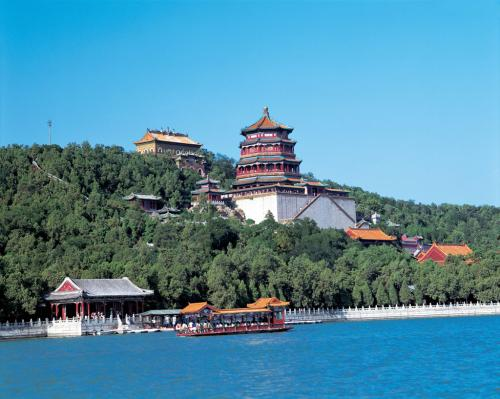沈阳故宫为清朝初期的皇宫,大家知道怎么向外国友人介绍吗?以下是小编整理的沈阳故宫导游词英文版,欢迎参考。
篇一:沈阳故宫导游词英文版
Hello, everyone! Please allow me to express a warm welcom#e on behalf of Shenyang citizens. I'm with great pleasure to be your tourist guide and from now on I will show you around Shenyang Imperial Palace, where the founder of Qing Dynasty Nuerhachi and his son Huangtaiji lived.
Shenyang Imperial Palace, Fuling tomb and Zhaoling Tomb made in the early period of Qing Dynasty are the three famous historical sites in Shenyang. Shenyang Imperial Palace with a history of over 360 years started in 1625 and was roughly accom#plished in 1636 during the reign of Nuerhachi and Huangtaiji. After them four emperors of Qing Dynasty had com#e back from Beijing to this palace for 10 times and enlarged its area and added its buildings. They were Emperor Kangxi, Qianlong, Jiaqing and Daoguang. Therefore, until 1783 the palace was finally finished. Shenyang Imperial Palace is one of the two royal palaces well kept in China. The other one is Forbidden City in Beijing. Shenyang Imperial Palace was entitled "Historic Culture Relics Preserved Buildings" in 1961 by the State Council. This palace is an emperor museum com#bining the architectural styles of the minorities of Man, Han and Mongolia. This palace covers an area of 60,000 square meters, com#prising over 20 courtyards, 300 houses and 70 buildings. The whole construction is divided into three sections: the east, middle and west.
First let's pay a visit to the buildings in the buildings in the middle section. The layout of middle section is similar to a Chinese com#pound with three courtyards. The first courtyard is the office area. It starts from the Grand Qing Gate on the south and ends at Holy Administration Hall. From Phoenix Tower to Purity and Tranquility Hall is the residential area. They all lay out on the same line. The main entrance to the palace is the Grand Qing Gate, also called Meridian Gate because the emperor considered himself as the son of Heaven and the palace should be the center of universe .The Grand Qing Gate was built in 1632 and is was the place where the civilian officials and military ministers to present themselves before the emperor daily .The special feature of the gate is the tile color. They are all yellow tiles but engraved with green borders. Yellow symbolizes the ground and the royal right while green represents sea and mountains. The com#bination of them means controlling the vast areas on the earth. The building to the east of Grand Qing Gate is called Ancestor Temple (Taimiao) with yellow tile roof, where Nuerhachi's descendants offered sacrifices to their ancestors for blessings. So Ancestor Temple is the most important. Please follow me into the gate. This path in the middle links the gate to Holy Administration Hall with Flying Dragon Pavilion (Feilongge) and Flying Phoenix Pavilion (Xiangfengge) on each side. The Hall of Holy Administration is the main building in the middle part of the palace and it was the center of the military, administrative affairs in early Qing Dynasty and had witnessed many national ceremonies. Flying Dragon and Flying Phoenix Pavilions were for storing music instruments. Holy Administration Hall was Emperor Huangtaiji's office. In front of the hall are Rigui and Jiangliang, which were used as measure instruments and supposed to be the symbol of unity. In accident construction, office area is usually in the front part and residential area is in the rear.
Since we have visited the place where the Emperors worked and now we'll pay a visit to the place where empress and concubines lived. Here is the Phoenix Tower. It served as an entrance to the rear chambers and also the entertainment area of Huangtaiji and his concubines, and some gatherings or banquets were held occasionally. The tower was built on a terrace 3.8 meters tall. It was the tallest building in Shenyang at that time .It is amazing watching sunrise in the morning on the tower and Phoenix Sunrise is one of the famous Eight fascinating Scenes in Shenyang. Look upward, we will see a board hanging up on Phoenix Tower ,on which Emperor Qianlong inscribed "Ziqidonglai", which meant the Qing Dynasty in Beijing immigrated from Shengjing, the old name for Shenyang to the east .There are 24staircases leading to Phoenix Tower representing 24 seasonal divisions points in Chinese lunar calendar.
Now notice the pole standing right in the middle of the courtyard. This red pole is called Suolun pole, or Holy Pole. Its round tin container near the top was filled with food for feeding crows. It was said that Nuerhachi was saved by crows. Crows are considered sacred in Manchurian culture though in Chinese culture crows are regarded as birds bringing bad luck. Emperor Huangtaiji had four concubines. Among the four concubines Chen was loved best by Huangtaiji and Concubine Zhuang was the wisest and the mother of the next emperor, Fulin. Therefore, she had a special status among the concubines. The only chimney was built on the rear of Purity and Tranquility hall from the ground with 11 layers, representing the 11 emperors from Emperor Huangtaiji to the last emperor Puyi. This chimney was the highest one at that time. In Chinese, the sound of chimney "tong" is the same as that of unity. To the north further is rear courtyard called Yuhua Garden. After visiting the middle section of the palace, we com#e to the eastern section. Its representative building is the Great Administration Hall, flanked by Ten Princes Pavilions. This part was built in 1625, and they were the earliest building in Shenyang Imperial Palace. Great Administration Hall is the place ceremonies and handled state affairs. Great Administration Hall was built with eight sides representing the style of military tent and also Eight Banner military system.
Now please look at the ten pavilions, five on each side, which were the offices of the com#manders at that time. Here I will give you an introduction to the military system of early Manchurian Period. Nuerhachi divided his troops in four parts and each part was identified by the color of its banner .There sere then four kinds of banner: red, blue, white and yellow banner. As the troops expanded quickly, another four parts were added and therefore another four kinds of banner were needed .By then there were altogether eight kinds of banner. This army was therefore well known for Eight Banner Army.




